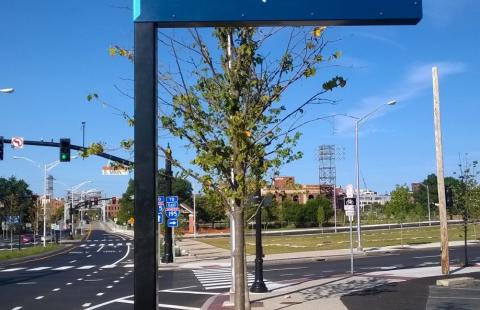What were the specific goals of this creative economy project? Describe the community development challenge or opportunity that your project was designed to address:
The project goals are:
• To help people navigate the downtown environment.
• To enhance the perception of downtown Providence and its offerings.
• To encourage greater visitation to and between downtown attractions.
• To assist drivers with finding parking near major venues.
• To improve the visual quality of the downtown area by replacing existing wayfinding signs with a new cohesive, recognizable system.
If the goals change over time, please describe how:
Initially, we worked with consultants that had identified locations for more than 100 signs within the project area. Several partners expressed concerns about signage clutter, and they advised us to reduce the total number of signs. Later, once we had selected a designer and approved a design, we began raising funds based on preliminary estimates. In March 2015, we issued a request for proposals for fabrication and installation, and we learned that the project cost was much higher than anticipated. We had to continue our fundraising efforts and we also considered installing the signs in stages. Ultimately, we did raise additional funds through significant grants from the Providence Tourism Council and Commerce Rhode Island for Main Street streetscape improvement. We also reduced the number of freestanding signs and replaced them with panels that can be mounted on existing light posts at a lower cost.
Who was involved in this project and what did they do? (be sure to include the partners from outside of the creative sector and how local voices were included):
The Providence Foundation has taken the lead role on the project, in partnership with the City of Providence Dept. of Planning and Development. Early on, we managed an active committed that helped us finalize our selection criteria, choose destinations and districts, and hire a designer. The following partner organizations were involved in that committee:
The Providence Foundation
Providence Downtown Improvement District
Providence Warwick Convention & Visitors Bureau
Providence Dept. of Planning & Development
Providence Dept. of Art Culture + Tourism
Providence Dept. of Public Works
Providence Performing Arts Center
RI Dept. of Transportation
RI Public Transit Authority
RI Convention Center Authority
Providence Revolving Fund
Roger Williams National Memorial
RI Historical Preservation & Heritage Commission
The Rhode Island Department of Transportation (RIDOT) played a significant role with helping us understand federal guidelines for signage, and coordinating sidewalk and road reconstruction projects in the downtown area. RIDOT also funded the fabrication and installation of 5 signs in the I-195 area in 2015, which helped to reduce our overall project cost. (A sample sign can be seen in the attached photo).
Once fundraising became our priority, the Providence Warwick Convention & Visitors Bureau and the Providence Department of Art, Culture + Tourism provided assistance. Now that we are preparing for installation, the Providence Department of Traffic and Engineering is very involved. They are coordinating with our contractors, and their team has removed existing signs.
How does this project relate to a larger community development strategy?
The Downtown Providence Wayfinding Signage project strongly supports local economic and community development goals. It encourages tourism in Providence, giving visitors a sense of arrival at key gateway locations and connecting them with information about the breadth of offerings downtown.
Designed by John Seeley, formerly of Selbert Perkins Design and now principal of Surface Matter Design which is based in Providence, the signs have simple layouts that relate to our capital city’s strong sense of place. The front panels feature messaging in a bright, legible modern font, while the back panels of each freestanding post feature stylized renderings of iconic Providence landmarks including Providence Performing Arts Center and the First Baptist Church in America. The signs are designed to be legible, and they should enhance but not compete with our beautiful built environment.
What projects or places, if any, inspired your approach to this creative economy project?
Direction Philadelphia, which started in the 1980s and has been very effective.
